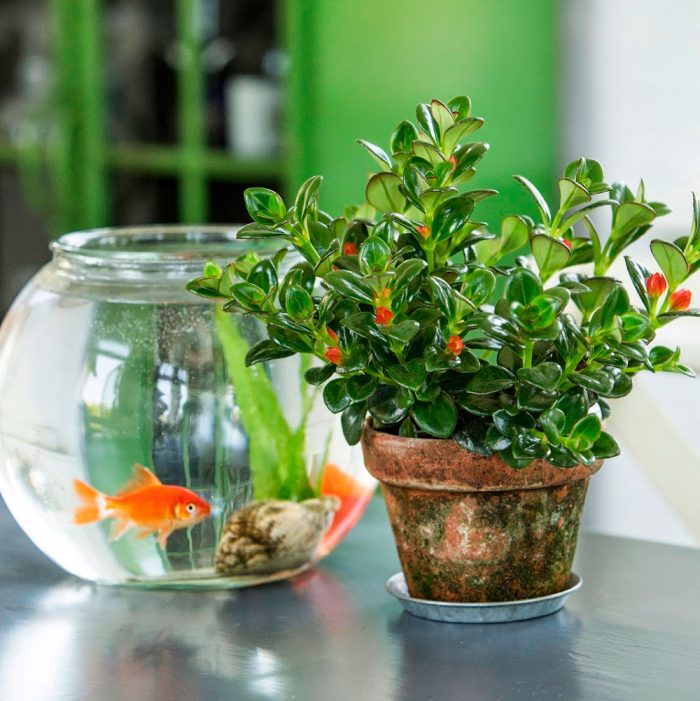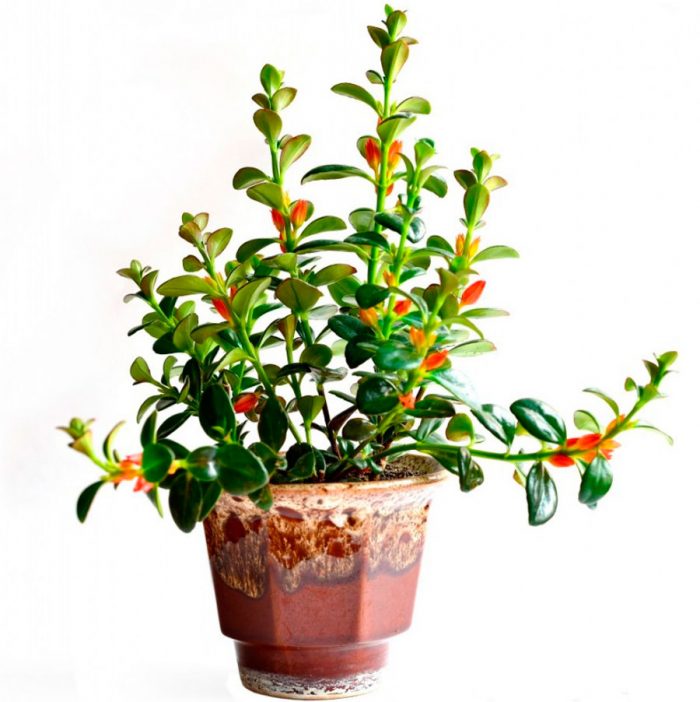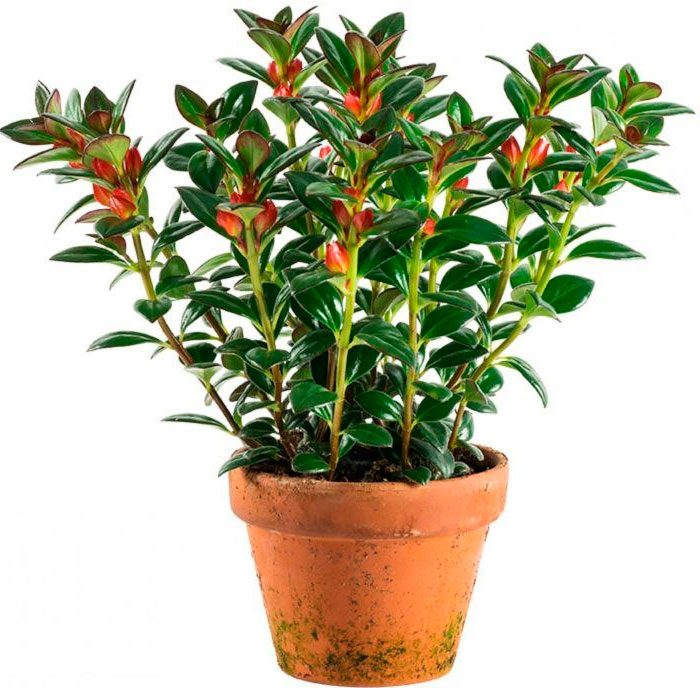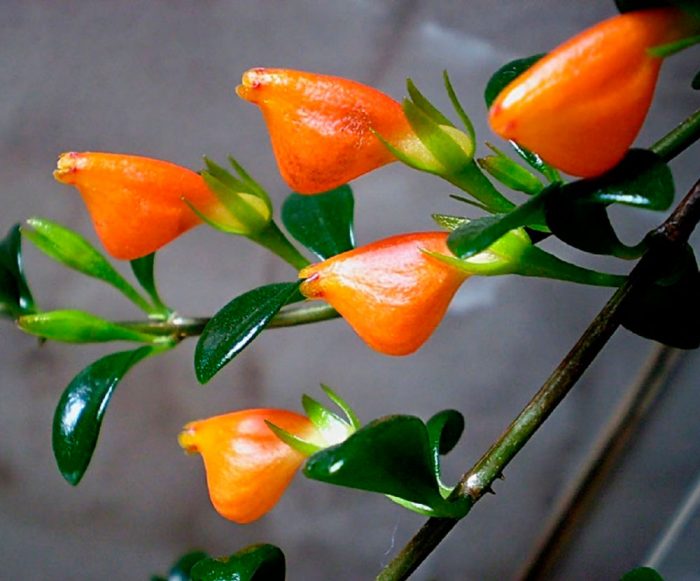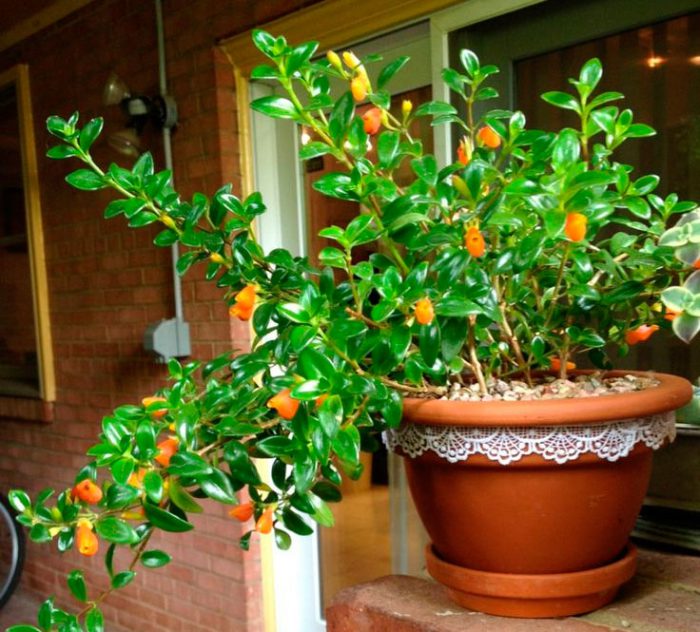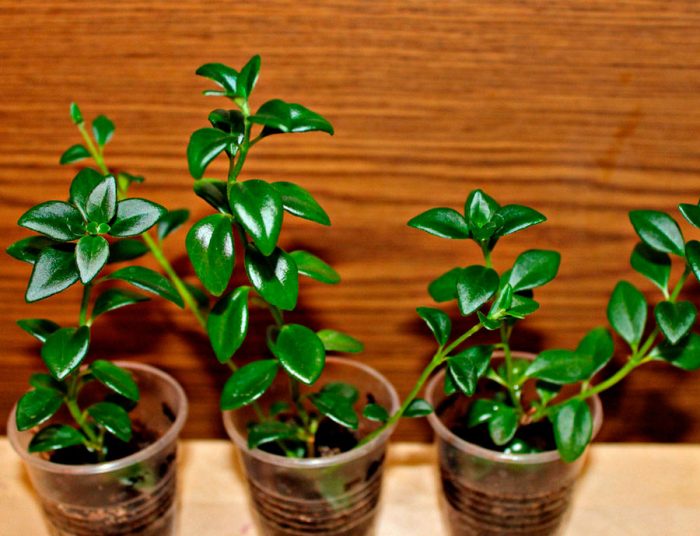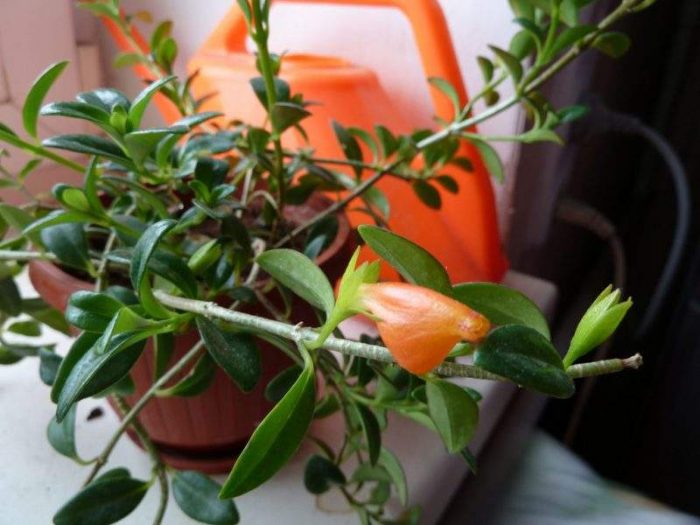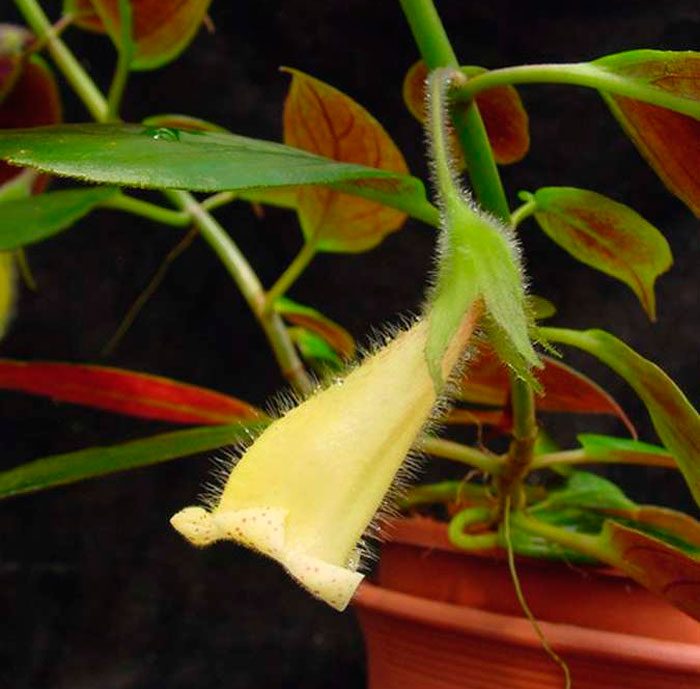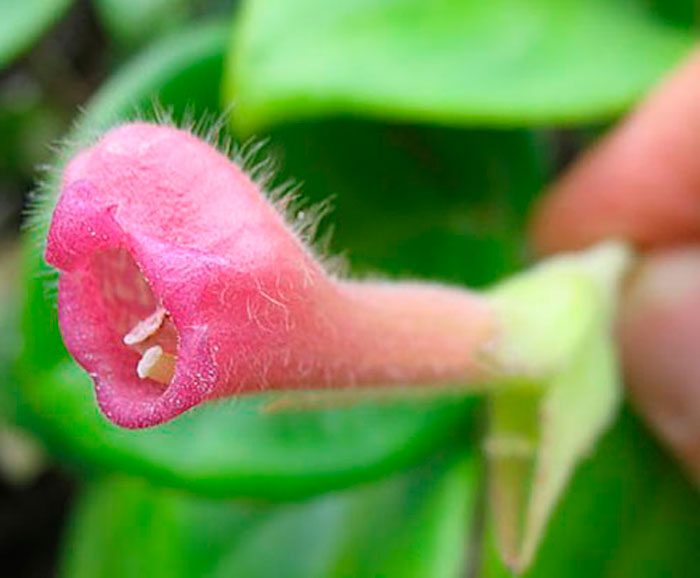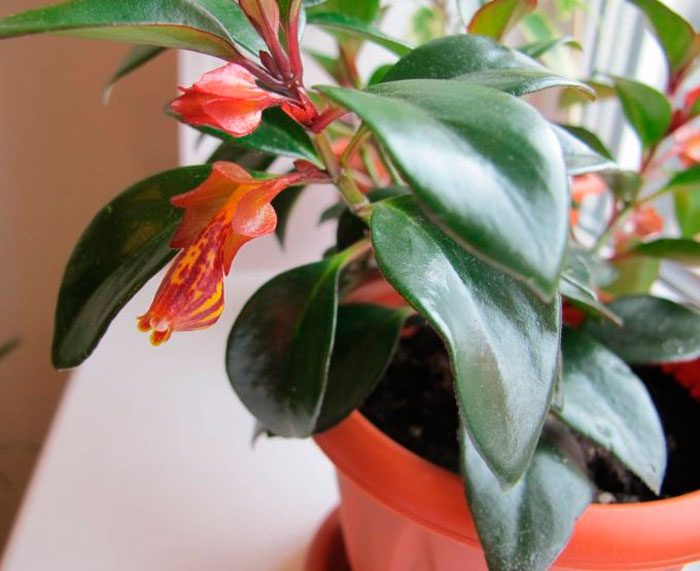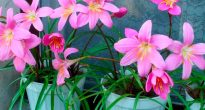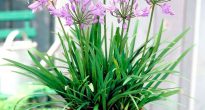The nematanthus plant is a member of the Gesneriaceae family. This genus unites 6 species, which are represented by shrubs, semi-shrubs, epiphytic and semi-epiphytic lianas. In nature, nematanthus is most often found in South America. The name of the genus comes from two Greek words: "nema", which is translated "thread", and "anthos" - "flower". The fact is that in some species of such a plant, the flowers have a long and thin pedicel. They can be colored orange, yellow, pink or red. Outwardly, nematanthus is very similar to columbia or zypocyrt. That is why some of the species of these plants were included in the genus Nematantus.
Content
Caring for nematanthus at home
Illumination
In order for the nematanthus to grow and develop within normal limits, it will need bright diffused lighting, and the duration of daylight hours should be from 12 to 14 hours. When choosing a suitable place for such a flower, preference should be given to window sills located in the western or eastern part of the room. This flower can also be grown on a north-facing window, but it should be borne in mind that in the cold season, the flower may not have enough light, which can have an extremely negative effect on flowering. If the flower is placed on the southern windowsill, then in the summer it will need mandatory shading at midday from the scorching direct rays of the sun, otherwise burns may appear on the surface of the leaves. In winter, the plant needs as much bright light as in summer. If the sunlight is not enough for the nematanthus, then it can be supplemented by installing, for example, a phytolamp. If the flower is very large, then placing it under a fluorescent lamp will be quite problematic.
Temperature regime
Throughout the growing season, the flower should be warm. It grows best at this time at an air temperature of 19-24 degrees. In winter, the nematanthus has a dormant period, during which the flower should be in a cooler place (from 14 to 16 degrees). The plant tolerates short-term temperature drops normally. However, if in the room in which it is located for a long time it will be colder than 13 degrees, then this will have an extremely negative effect on its decorative effect.If the air temperature in the room drops to 7 degrees, then the foliage will turn brown and fly around. If, on the contrary, it is very hot (27 degrees or more), then this will also negatively affect the development of the flower. The flower responds well to a decrease in air temperature at night by 5-10 degrees.
Watering
In the warm season, during the period of active growth, the nematanthus is watered regularly and abundantly, immediately after the top layer of the soil mixture in the container dries out. With the onset of a dormant period in the cold season, the abundance and frequency of watering must be reduced, especially if the flower is in a cool room. It is only necessary to moisten the soil mixture in a flower pot with well-settled, soft water, the temperature of which should be close to room temperature. If a species is grown with rather large leaf plates that absorb a larger volume of water, then it is recommended to resort to differential watering, and it is necessary to take into account the size of the bush, the size of the foliage and the composition of the soil mixture.
You can understand that the plant does not have enough water by the following signs: small leaf plates fly around, and large ones curl. If the earthen lump is very dry in the pot, then you will need to immerse the bush along with the container in a basin filled with water. After the dried substrate is saturated with water, the pot with nematanthus is pulled out of the basin. If a void appears between the lump of earth and the pot, then it must be filled with fresh substrate.
Air humidity
The optimum level of air humidity for indoor nematanthus is about 50%. It should be borne in mind that the warmer in the room, the higher should be the level of humidity and vice versa. If the air temperature in the room is not more than 21 degrees, then the air humidity should be about 50%. At an air temperature of up to 27 degrees, the humidity level must be increased to 60%.
In the spring-summer period, the flower responds well to daily moisturizing from a sprayer, for this it is recommended to use warm and soft water. With a cool winter, it is impossible to moisten the bush, but if there is a need to increase the level of air humidity, then a pallet filled with wet pebbles or expanded clay is taken, and a pot with nematanthus is placed on it.
Top dressing
During the growing season, the plant is fed regularly once every 15 days, for this, a complex mineral fertilizer is used. In autumn, the flower is fed less often, and in winter, fertilizers are not applied to the soil mixture at all.
Flowering and pruning
Flowering of nematanthus begins in spring and ends in autumn. However, if the flower receives enough light in winter, then it may begin to bloom. This plant differs from many others grown indoors in that its flowers are formed only on young shoots. In this regard, for a lush and spectacular flowering, it is necessary to systematically carry out anti-aging pruning of the bush. As a rule, the bush is pruned immediately after it has faded. If in winter the flower is not transferred to a cool place, then its shoots are strongly stretched. In this case, in early spring, you will need to carry out another pruning in order to shorten the too long stems.
If the bush is already very old, it may lose its decorative effect. But do not rush to throw it away. Cut off its most powerful shoots and root them like normal cuttings. Thanks to this, instead of one old one, you will have several young and beautiful bushes.
Transfer
Nematanthus is transplanted in the spring, but only when necessary. When choosing a new pot for transplanting, it should be borne in mind that it should only be slightly larger than the old one, since in a too spacious container the bush may not bloom for a long time. So, the new container should be 10–20 mm larger than the old one.
At the bottom of the pot, it is imperative to make a good drainage layer so that no stagnation of liquid is observed in the substrate, which must be necessarily loose. The soil mixture should be light, loose, water and air permeable, neutral or slightly acidic with a pH of 5.5–6. The approximate composition of a soil mixture suitable for growing nematanthus may be as follows: leaf earth, sand, peat and humus, taken in a ratio of 2: 1: 1: 1. It is recommended to add small pieces of charcoal and sphagnum moss chopped with scissors to the finished substrate.
Reproduction methods
Growing from seeds
Indoor nematantus can be grown from seeds if desired. When the pods that appear after flowering are fully ripe, take a white paper sheet and sprinkle seeds on it, which are very, very small. Fill a small container with substrate, level the surface and moisten. To sow seeds evenly, they must be scattered from a piece of paper, while lightly tapping on it. It is not necessary to sprinkle the seeds with earth, however, the container with the crops must be covered with foil or glass. Crops are moistened by bottom irrigation (through the pallet). After the first seedlings appear, be sure to remove the shelter. The grown seedlings must be dived, while it is recommended to plant several plants at once in one pot, so that the bush is more lush and effective. The bushes will bloom in a year.
Cuttings
Such a flower can also be propagated by apical or stem cuttings. Cuttings can be harvested at any time of the year, while their length should be 70–100 mm. All leaf plates are cut off from the lower third part of the segment, after which it is planted for rooting in a loose substrate that allows air to pass through well, or in sphagnum moss. The parent bush from which the cuttings were taken, at first it is recommended that it be shaded from the direct rays of the sun. It is recommended to plant rooted cuttings in a permanent pot, several pieces at a time. After a while, they will begin to grow actively and become lush bushes.
Diseases and pests
If the nemantus is not properly looked after or if optimal conditions for growth are not provided for it, then the following problems may arise with it:
- Brownish specks form on foliage... This happens if excessively cold water is used for irrigation. Remember that its temperature should be around 20 degrees.
- Foliage flies... If the bush began to lose leaves in autumn or winter, then this indicates that the room is too cold.
- The root system is dry. This is observed in the summer, with very rare or poor watering, when the soil mixture in the pot dries up very much.
- Yellowing and drying of the tops of the leaf plates... The air in the room is too dry.
- The flowers turn brown and fly around... This can be due to the fact that water droplets fall on the surface of the flowers. Therefore, moisten the bush from a sprayer during flowering very carefully.
If the humidity is too high, the plant can be affected by gray rot, and pests such as thrips, aphids and spider mites sometimes settle on it.
Types of nematanthus
Riverine nematantus
This species is represented by climbing plants. Opposite-located leaf plates have an elliptical shape, in length they reach about 50-100 mm. The leaves are painted satin green, and their seamy surface has a pale red tint.
Nematantus Fritsch
In natural conditions, the bush has a height of about 0.6 m. The lower surface of the spectacular green foliage is pale red, in length it reaches about 75 mm. In deep pink flowers, the diameter of the funnel is up to 50 mm.
Nematanthus ankle
The species is represented by climbing epiphytic shrubs.Greenish smooth oppositely located leaf plates have an elliptical shape, their width is up to 40 mm, and their length is about 100 mm. During flowering, pedicels grow from the leaf sinuses, which reach about 100 mm in length. Funnel-shaped single flowers have a scarlet-red color, there is a swelling at the base of the corolla tube. The calyx contains 5 narrow incised segments.
Nematantus Vetstein
In culture, the species is grown as an ampelous plant. Strongly branching thin shoots can be about 0.9 m long. There is a waxy bloom on the surface of the dark green small oval leaves. The length of the flowers is about 25 mm, they have a red-orange color with admixtures of yellow. The species blooms for a relatively long time and magnificently.
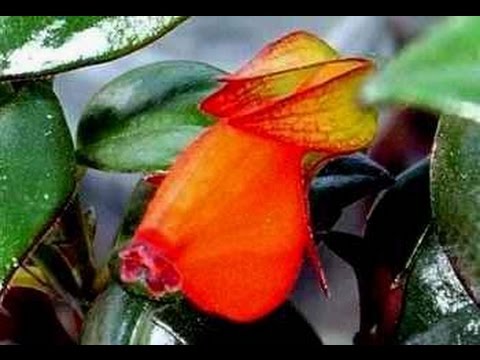

Watch this video on YouTube

